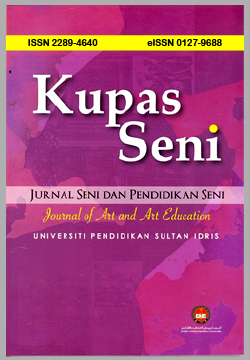Art Appreciation Aznan Omar's Solo Exhibition: Printing Satire
DOI:
https://doi.org/10.37134/kupasseni.vol10.2.3.2022Keywords:
appreciate, meaning, satire, iconographyAbstract
Artworks carry their own meaning based on the idea that an artist wants to share or convey. In this writing, there will be a discussion about art appreciation of the artworks which have been presented in the solo exhibition of Aznan Omar: Mencetak Satira which took place from July 23rd, 2011, to August 6, 2011. This art exhibition was held at the House of Matahati (HOM). His artworks are presented using the technique of metal casting or lost-wax casting. In the appreciation of artwork, two sculptures are randomly selected to be discussed. This writing uses the iconographic approach to art that has been introduced by Erwin Panofsky for a clearer understanding of art appreciation. From an iconographic point of view, Erwin Panofsky has developed three levels of appreciation and understanding of works of art. The three levels of appreciation include: pre-iconography; the second is iconographic analysis; and the third is iconological interpretation. The outcomes from this discussion will explain the understanding of iconology as part of the identification of items and iconography, which is more of the description and classification of subjects in art. Aznan Omar's artworks presented in this solo exhibition, satirical in nature, can be appreciated with the understanding that has been defined.
Downloads
References
Katalog Pameran. (2011). Katalog Pameran Solo Aznan Omar: Mencetak Satira., Ampang, Selangor: House of Matahati.
Baharom, N. (2007). Kamus Dewan (Edisi Keempat). Kuala Lumpur: Dewan Bahasa dan Pustaka.
Badaruddin, M. I., Soon, S., Lee, L., Sahibil, Z., & Saad, M. L. I. H. M. (2019). Teori dan Kaedah Analisa Terhadap Nilai Apresiasi Motif Reka Corak Tradisional Melayu: Satu Perbandingan Umum. International Journal of Heritage, Art, and Multimedia, 2(5), 56-71.
Barrett, T. (1994). Criticizing Art: Understanding the Contemporary. Mountain View: Mayfield Publishing Company. California.
Creswell, J. W. (2014). Research design: Qualitative, Quantitative & Mixed Methods Approaches. California: SAGE Publication Inc.
Desa, N. E., Syed Abu Bakar S. A., & Muhammad N. A. (2020). The Basis of Art Appreciation Idealogy Journal, Vol. 5, Perak: UiTM Press, 97-106
Desa, N.E., Muhamad, N.A., & Syed Abu Bakar, S.A, (2021). Asas Apresiasi Seni Dari Perspektif Formalistik,Rupa Dan Makna. Gendang Alam. Gendang Alam, Jilid 11 (2), Universiti Malaysia Sabah: Sabah,11 (2), 97-112.
Djahwasi, H.R. & Saidon, Z.L. (2020). Artistic Research: Artistic as Research vs Artistic as Method. International Journal of Academic Research in Business and Social Sciences. Pg. 292 – 309 http://dx.doi.org/10.6007/IJARBSS/v10-i11/8091
Edmonds, W.E.& Kennedy T.D. (2017). An Applied Guide to Research Designs: Quantitative, Qualitative, and Mixed Methods. Second Edition, United States of America: SAGE Publications, Inc.
Feldman, E. B. (1994). Practical Art Criticism. Upper Saddle River, NJ: Prentice Hall.
Husen, W.R. (2018). Pengembangan Apresiasi Seni Rupa Siswa Sekolah Dasar Melalui Pendekatan Kritik Seni Pedagogik. Vol.2 No.1 (2017): NATURALISTIC: Jurnal Kajian Penelitian dan Pendidikan dan Pembelajaran. https://journal.umtas.ac.id/index.php/naturalistic/article/view/100/439
Ishiguro, C. & Okada, T. (2019). How does art appreciation promote artistic inspiration? Conference: Cognitive Science Society.https://www.researchgate.net/publication/332978268_How_does_art_appreciation_promote_artistic_inspiration
Ismail, I. & Jusilin, H. (2020). Seni Visual Dalam Konteks Gejala Sosial di Malaysia: Interpretasi Simbolik Pada Karya Catan Fawwaz Sukri. Gendang Alam. Gendang Alam, Jilid 10, Universiti Malaysia Sabah: Sabah, 159-174.
Leavy, P. (2017). Research Design: Quantitative, Qualitative, Mixed Methods, Arts-Based, and Community-Based Participatory Research Approaches. New York: THE GUILFORD PRESS
Mohd Johari, A. H. (2007). Falsafah dan kritikan seni. Tanjong Malim: Penerbit Universiti Pendidikan Sultan Idris.
Muhamad, N.A, Tahir, A. Desa, N.E, (2021). Art Appreciation: The Expression of Etching in Printmaking through Mohd Fawazzie Arshad’s Artwork. Ideology Journal, Volume 6 (1), Perak: UiTM Press, 35-42.
Noor, R.M, & Khairani, M.Z. (2019). Tinjauan Terhadap Pendekataan Apresiasi Dan Kritikan Seni Dalam Memahami Karya Seni Rupa. Gendang Alam, Jilid 9, Universiti Malaysia Sabah: Sabah,109-119.
Ocvirk, O. G., Stinson, R. E., Wigg, P. R., Bone, R. O., & Cayton, D. L. (2009). Art fundamentals theory and practice (11th ed.). New York: McGraw Hill.
Panofsky, E. (1955). Meaning in the visual art. Garden City, NY: Doubleday Anchor Books.
Rondhi, M. (2017), Apresiasi Seni dalam Konteks Pendidikan Seni, Journal Imajinasi, 11(1). https://journal.unnes.ac.id/nju/index.php/imajinasi/article/view/11182/6726
Salam, S., Sukarman, Hasnawati, & Muhaimin, M. (2020). Pengetahuan Dasar Seni Rupa. Universitas Negeri Makassar: Percetakan MEDIA SEMBILAN SEMBILAN
Satwiko, P., Sunarya, W., Suwarno, N., Yudhatama, S. (2021), Apresiasi Estetika 1. Yogyakarta: Cahaya Atma Pustaka.
Soewarlan, S. (2015). Membangun Perspektif: Catatan Metode Penelitian Seni. Jebres, Surakarta: ISI Press.
Sidek, F. (2015). 40 Tahun Anugerah Bakat Muda Sezaman. Dewan Budaya (pp. 48-51).
Subramaniam, M., Hanafi, J., & Putih, A.B. (2016). Malaysian Online Journal of Educational Technology, 4 (1), 57-67.
Downloads
Published
Issue
Section
License
Copyright (c) 2022 Noor Enfendi Desa, Noor A’yunni Muhamad, Mohd. Fawazie Arshad, Izzal Khairi Ramli

This work is licensed under a Creative Commons Attribution-NonCommercial-ShareAlike 4.0 International License.





